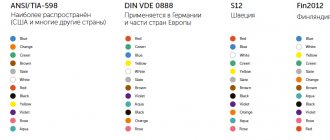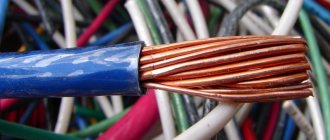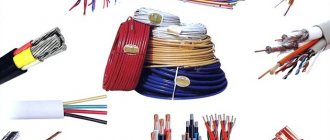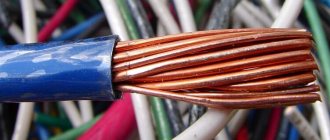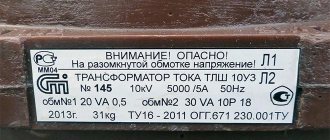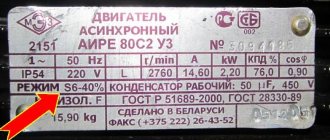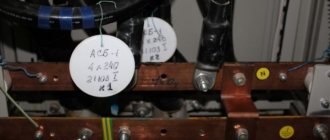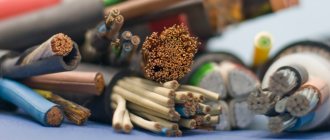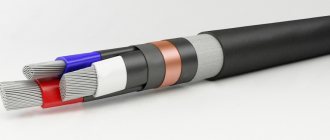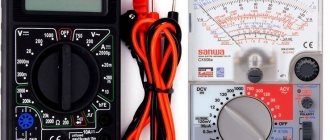We have prepared for you a decoding of the markings of cables and wires with a table so that you can conveniently interact with it during installation and operation. Signs are placed on them so that the consumer knows what kind of cord it is and what is inside it. All these numbers, letters and colored lines are applied to the product at the factory to separate brands with some characteristics from their counterparts with other functions. To understand this issue, read and apply certain rules.
Purpose of marking
Most consumers, when faced with markers for the first time, do not understand what these numbers and letters in the composition mean. There are different models on the market: both domestic and foreign, which indicate:
- The material used to make the wire cores, as well as their number. Often created from aluminum and copper. Multicore conductors. There are unusual varieties in which these elements are made of steel or composite.
- Type of insulation. This designation tells what the insulating shell of all layers is made of. This can be polyvinyl chloride, rubber, fluoroplastic and other materials.
- Section. The indicator shows the area of the current-carrying part when viewed through a cross section. It determines how much resistance the conductor will provide to electric current. The standard ranges from 0.35 to 240 mm.
- Area of use. A mandatory mark that will tell you how resistant the wire will be to an aggressive environment.
- Design features. Noting additional items or unusual materials used. Sometimes it is an indicator of the specificity of manufacturing technologies.
- How flexible. Indicates how well this instance will bend. Marked from 1 to 6, where 1 shows no flexibility, and 6 bends as much as possible.
- Electricity is at par. Separates the operating voltage for which the insulation is calculated.
The most important differences
Wire markings for electrical wiring and other purposes are made to indicate certain design features that correspond to the type of product.
According to this division, it is a product of a monolith or stranded current-carrying part, which is capable of incorporating insulating layers or functioning without them.
An electrical cord consists of conductive elements with insulated layers; inside it has a multi-wire structure for connecting to the power supply of devices.
It is sold in the form of single-core and with a large number of cores. It has more than 2 layers of insulating gasket, there is an armor screen and other particles, their presence and quantity depends on the design and purpose - communication, control, power and radio frequency.
If we take into account the above division, we can understand what lies in front of the client. For a knowledgeable person, one glance at a wire is enough to understand what its role is in a particular electronic installation. To make this clear, we propose to analyze all the designations of common models in devices.
Origin of the term
The word "cable" is of German origin. Cabel is always something extended; this root is often found in marine terminology.
- Kabeltov is a maritime unit of length, 1/10 of a mile, equal to 185 meters.
- A cable cable is a structure whose strands are woven fourfold.
Therefore, it is academically correct to use it in relation to conductive parts that have an infinitesimal thickness compared to their length and consist of three or more metal conductors isolated from each other.
Alphanumeric markers
Most of the cables have letters and numbers on their surface. Each is responsible for a specific function or purpose. Symbols are necessary because there are special regulations for manufacturers, confirmed by regulatory documents.
It is worth noting that in modern conditions everything is created not according to standards, but according to technical conditions. What will be written may vary greatly depending on the field.
Designation of markings of power cables and electrical wires and their interpretation
These models differ in their characteristics - they contain conductors with a cross-section that can power the equipment. But remember that such equipment includes household consumers and at the same time serious devices in enterprises with enormous power.
To correctly decipher the letters on the surface, we provide a small list:
- If it starts with marker A, then the main part is aluminum. The absence of "A" indicates a copper element.
- B – stands after A or first if there is no A. Indicates the presence of insulation around a live part.
- B - reports a PVC insulating layer, can appear after the previous characters or 1 in the list.
- P - means that there is rubber around the core. HP subtype - will not support combustion.
- P – is responsible for the polyethylene sheath; in the case of cable products, this is a thermoplastic variety. They write Ps if it is self-extinguishing, Pv if it is vulcanized.
- If AC or AA are combined, then the second symbol means aluminum winding, and C means lead winding.
- K – armored galvanized steel under the hose part, but it is designated this way only if the abbreviation does not begin with it. If this is the first character, then it indicates that we have a control cable.
- B features an armored section made of a steel plate. If it has the addition Bn, then it is armor with a non-flammable coating, otherwise there is no cushion.
- G – if the letter is large, it means that this brand can be installed even in mine workings.
- d – small indicates that there is sealing. Usually the sealing layer is made with water-repellent tapes. 2g is an aluminum polymer base.
- Shv, Shp and Shps indicate that the coating is made of PVC, polyethylene or non-flammable hose.
- O - signals that everyone will have their own shell.
- ng - symbolizes that the material does not burn and does not burn in any way.
- E - if it is at the very beginning, then this is a model that will withstand placement in a mine and with particularly aggressive conditions.
For control models
Able to transmit a control signal to any device to which it is connected. It is used when it is important to obtain accurate data.
Explanation of the designation of the cross-section of cables and various wires of this category:
- K – belonging to the control group. It can stand in either 1st or 2nd place, indicating the material of the core.
- A – indicates the presence of aluminum. If there is no symbol, then the option in front of you is copper core.
- B - denotes polyvinyl chloride as insulation near the live part.
- c – the outer side is made of the same material.
- P - makes it clear that the insulating element was formed from polyethylene.
- F – fluoroplastic layer.
- P - indicates the presence of rubber as an insulator. HP is a rubber shell that will not support combustion.
- G – confirms that the selected model is naked.
- E - if not at the beginning of the line, then this is the screen in the composition.
It is worth noting that the KG coding usually marks not the cord for controlling devices, but the flexible cable.
For contact
For these lines, they came up with special brands that have their own markings for cable products and electrical wires. In standard cases, these are examples for small current, which have a small cross-section and a large number of pairs.
Descriptions are registered on them:
- T – telephone;
- P – polyethylene insulation;
- p – waist insulating material made of PVC or polyethylene terephthalate;
- P - if they come in a row, then this is an additional protective shell;
- E – screen, this is one of the elements required for signalmen;
- Z - indicates that there is a hydrophobic filler that will retain penetrating moisture;
- C – used only on railways.
How to decipher a digital designation
Usually 3 digits are used, which take on the parameters:
- how many lived - there is 1 or many, each is marked;
- cross-section - if there are conductors with different indicators, they are marked separately;
- shows the nominal voltage, but it is not always there.
How wires and various cords are marked
The principle by which markers will be placed on them differs from that used for cables. All requirements are specified in GOST 7399-97.
In this area, AC will mean that it is an aluminum core with a steel core. We are not talking about isolation here.
SIP will mean a product that has several types, it is self-supporting and at the same time insulated.
PPV indicates the presence of a flat core and an insulating layer of polyvinyl chloride.
MG is a flexible copper product.
These are only private variants of the most commonly used names. But you can find a lot of foreign options that will differ in markers.
Conditions of use
Cable, unlike wire, has found wider application in special conditions. Having increased protection against mechanical and aggressive damage, it is laid under water. All underground communications are carried out only by him. In addition, they are used in mines, fire hazardous areas, areas with increased corrosive activity and other places.
Wires are used only inside electrical distribution devices. Outside these limits, it is recommended to use cables or conductive bars. As an example, consider the PV-3 wire. This is an installation copper wire with a stranded core. Suitable for use in baths and bathrooms. Does not burn. It has found wide application in the installation of apartment electrical wiring. It has increased flexibility, which makes it different from other wires.
Ready-made solutions for all areas
Stores
Mobility, accuracy and speed of counting goods on the sales floor and in the warehouse will allow you not to lose days of sales during inventory and when receiving goods.
To learn more
Warehouses
Speed up your warehouse employees' work with mobile automation. Eliminate errors in receiving, shipping, inventory and movement of goods forever.
To learn more
Marking
Mandatory labeling of goods is an opportunity for each organization to 100% exclude the acceptance of counterfeit goods into its warehouse and track the supply chain from the manufacturer.
To learn more
E-commerce
Speed, accuracy of acceptance and shipment of goods in the warehouse is the cornerstone in the E-commerce business. Start using modern, more efficient mobile tools.
To learn more
Institutions
Increase the accuracy of accounting for the organization’s property, the level of control over the safety and movement of each item. Mobile accounting will reduce the likelihood of theft and natural losses.
To learn more
Production
Increase the efficiency of your manufacturing enterprise by introducing mobile automation for inventory accounting.
To learn more
RFID
The first ready-made solution in Russia for tracking goods using RFID tags at each stage of the supply chain.
To learn more
EGAIS
Eliminate errors in comparing and reading excise duty stamps for alcoholic beverages using mobile accounting tools.
To learn more
Certification for partners
Obtaining certified Cleverence partner status will allow your company to reach a new level of problem solving at your clients’ enterprises.
To learn more
Inventory
Use modern mobile tools to carry out product inventory. Increase the speed and accuracy of your business process.
To learn more
Mobile automation
Use modern mobile tools to account for goods and fixed assets in your enterprise. Completely abandon accounting “on paper”.
Learn more Show all automation solutions
Designation of special cable characteristics
Helps to understand the special performance characteristics of the cable. Let's consider them according to GOST:
- “A” means that the cable is paved;
- “B” has armor tapes;
- “G” is a flexible wire without protection;
- “K” is armored with round wire;
- “T” is made for use on pipe bases;
- “O” received additional protection in the form of braiding.
Let us note the designation frls, since although it is added at the end, it provides information about combustion resistance, which is important for fire safety. It is divided into two abbreviations. FR indicates the level of fire resistance, and LS indicates the small amount of smoke produced when ignited.
This type of cable may remain functional for some time during a fire. This is important for the functionality of the fire warning system.
Now you know how to correctly decipher cables or wires and can understand their markings. This will help in various situations related to laying electricity to buildings or creating wiring inside them using your own efforts.
Color coding
To further separate the electrical wires, different colors are used. If a person does twists not for the first time, it will not be difficult for him to almost automatically figure out what is responsible for what. Standards are used in production, so it becomes possible to complete the installation for another person.
A few important color options:
- grounding or “earth” – greenish-yellow, blue-black, white (not always);
- zero – blue or cyan;
- the combined conductor is yellowish-green with splashes of blue.
The shade of the “phase” may vary from one manufacturer to another, but not much. In this case, you have to focus on the “ground” option.
Confusion about standards
In theory, there can be no double interpretation of anything in electrical engineering. It's like an exact mathematical science. Everything here should be clearly standardized, terminologically correct and unambiguous. But as they say, everything is one thing in theory, but another in practice. And an example of this is the question of correct color marking of conductors and terminals of electrical equipment.
Why does this notorious confusion arise? It's simple. When issuing new GOSTs, for some reason the people responsible for this do not terminate the validity of previous related GOSTs. This results in a double interpretation of the same rules and requirements.
In our case, before GOST 33542-2015, GOST R 50462–2009 was in force. And before GOST R 50462–2009, GOST R 50462–92 was in force. And before GOST R 50462–92, GOST 12.2.007.0–75 was in force. And what do you think? The older GOST R 50462–2009, GOST 12.2.007.0–75 continue to be valid today! But it is logical that they should be cancelled. You can see this for yourself by going to the ROSSTANDART website and checking the validity period of these GOSTs.
In my opinion, it is blatant negligence and stupidity to create standards about the same thing WITHOUT prohibiting the actions of older ones.
Tables
We suggest you look at what different brands of wires and cables for electrical wiring will look like and their interpretation in the table.
The principle of labeling foreign products
| What does it look like in the standard | Deciphering | |
| Type | ||
| N | Power | |
| H | agreed upon | |
| Rated voltage | ||
| 03 | 300V | |
| 05 | 300/500V | |
| 07 | 450/750V | |
| The core that carries the current | ||
| Cu | Copper | |
| A, AL | Aluminum | |
| Insulation layer | ||
| Y,PVC | Polyvinyl chloride | |
| V | ||
| G | Rubber material | |
| R | ||
| N | Polychloroprene rubber | |
| S | Rubberized Silicone Matter | |
| 2Y | Polyethylene | |
| 02Y | Polyethylene that has been foamed | |
| 02YS | ||
| XLPE, 2X | Polyethylene, which has a porous film-foam structure | |
| Semiconductor | ||
| H | semiconductive | |
| Screen | ||
| C, S | Copper screen | |
| A | Aluminum foil | |
| F | The presence of a hydrophobic filler in the cable core | |
| F(Y)2Y | In addition to the above, aluminum shell | |
Design features of power cables
| Brand | Cores made of (A)aluminum or (M)edium | Insulating layer, where P is polyethylene | Shell made of (P) polyethylene, V-PVC regular, Vng its non-flammable analogue | Is there protection |
| APVG | A | P | IN | No |
| AVVG | A | IN | IN | No |
| VVG | M | IN | IN | No |
| AVVGng | A | IN | Vng | No |
| VVGng | M | IN | Vng | No |
| AVVGz | A | B (filler included) | IN | No |
| VVGz | M | B (filler included) | V | No |
| AVBbShv | A | IN | No | BbShv |
| VBBShv | M | IN | No | BbShv |
| AVBbShng | A | IN | No | BbShng |
| VBBShng | M | V | No | BbShng |
| AVVB | A | V | IN | B |
| VVB | M | V | IN | B |
Design features of control cables
| Brand | Cores made of (A)aluminum or (M)edium | Insulating layer, where P is polyethylene | Shell made of (P) polyethylene, V-PVC regular, Vng its non-flammable analogue | Is there protection |
| AKPVG | A | P | IN | No |
| KPVG | M | P | IN | No |
| AKVVG | A | IN | IN | No |
| KVVG | M | IN | V | No |
| AKVVGng | A | IN | Vng | No |
| KVVGng | M | IN | Vng | No |
| AKVVGz | A | B (with filler) | IN | No |
| KVVGz | M | B (with filler) | IN | No |
| AKVBBShv | A | IN | No | BbShv |
| KVBBbShv | M | IN | No | BbShv |
What technical indicators do cords and wires have?
| Brand | Number and nominal cross-section of cores, mm2 | Core class according to GOST not lower, or design | Nominal thickness, mm | External dimensions, mm | Electrical insulation resistance at 70 °C, MOhm per 1 km, not less | ||
| isolation | shell | min | Max. | ||||
| SHOG | — | Two strands of tinsel threads | 0,8 | — | 2,2×4,4 | 3,5×7,0 | 0,019 |
| ShVP-2 | 2×0,35 | 5 | 0,8 | — | 2,2×4,5 | 2,6×5,2 | 0,016 |
| 2×0,50 | 0,5×5,0 | 3,0×6,0 | 0,016 | ||||
| 2×0,75 | 2,7×5,4 | 3,2×6,4 | 0,014 | ||||
| Ball screw | 2×0,50 | 6 | 0,8 | — | 2,5×5,0 | 3,0×6,0 | 0,016 |
| 2×0,75 | 2,7×5,4 | 3,2×6,4 | 0,014 | ||||
| SHVD | 1×0,50 | 6 | 0,8 | — | 2,3 | 2,7 | 0,016 |
| 1×0,75 | 2,6 | 2,9 | 0,014 | ||||
| GDP | 2×0,50 | 5 | 0,5 | 0,6 | 3,0×4,8 | 3,6×6,0 | 0,012 |
| 2×0,75 | 3,2×5,2 | 3,9×6,4 | 0,010 | ||||
| 3×0,50 | 3,0×6,7 | 3,3×7,4 | 0,012 | ||||
| 3×0,75 | 3,2×7,4 | 3,6×8,2 | 0,010 | ||||
| ShVL | 2×0,50 | 5 | 0,5 | 0,6 | 4,8 | 6,0 | 0,012 |
| 2×0,75 | 5,2 | 6,4 | 0,010 | ||||
| 3×0,50 | 5,0 | 6,2 | 0,012 | ||||
| 3×0,75 | 5,4 | 6,8 | 0,010 | ||||
| ShPS | 2×0,50 | 4 | 0,5 | 0,8 | 5,1 | 5,7 | 0,012 |
| 2×0,75 | 3 | 5,5 | 6,1 | 0,010 | |||
| 3×0,50 | 4 | 5,4 | 6,0 | 0,012 | |||
| 3×0,75 | 3 | 5,8 | 6,4 | 0,010 | |||
| SHVG | 2×0,50 | 5 | 0,5 | 0,8 | 5,1 | 6,0 | 0,012 |
| 2×0,75 | 5,6 | 6,6 | 0,010 | ||||
| 3×0,50 | 5,4 | 6,4 | 0,012 | ||||
| 3×0,75 | 5,9 | 6,9 | 0,010 | ||||
| 4×0,50 | 5,9 | 6,9 | 0,012 | ||||
| 4×0,75 | 6,0 | 7,0 | 0,010 | ||||
| PVS | 2×0,75 | 5 | 0,6 | 0,8 | 6,0 | 7,6 | 0,011 |
| 2×1,00 | 0,6 | 0,8 | 6,4 | 8,0 | 0,010 | ||
| 2×1,50 | 0,7 | 0,8 | 7,4 | 9,0 | 0,010 | ||
| 2×2,50 | 0,8 | 1,0 | 8,9 | 11,0 | 0,009 | ||
| 3×0,75 | 0,6 | 0,8 | 6,4 | 8,0 | 0,011 | ||
| 3×1,00 | 0,6 | 0,8 | 6,8 | 8,4 | 0,010 | ||
| 3×1,50 | 0,7 | 0,9 | 8,0 | 9,8 | 0,010 | ||
| 3×2,50 | 0,8 | 1,1 | 9,6 | 12,0 | 0,009 | ||
| 4×0,75 | 0,6 | 0,8 | 6,8 | 8,6 | 0,011 | ||
| 4×1,00 | 0,6 | 0,9 | 7,6 | 9,4 | 0,010 | ||
| 4×1,50 | 0,7 | 1,0 | 9,0 | 11,0 | 0,010 | ||
| 4×2,50 | 0,8 | 1,1 | 10,5 | 13,0 | 0,009 | ||
| 5×0,75 | 0,6 | 0,9 | 7,4 | 9,6 | 0,011 | ||
| 5×1,00 | 0,6 | 0,9 | 8,3 | 10,0 | 0,010 | ||
| 5×1,50 | 0,7 | 1,1 | 10,0 | 12,0 | 0,010 | ||
| 5×2,50 | 0,8 | 1,2 | 11,5 | 14,0 | 0,009 | ||
| PVSP | 2×0,75 | 5 | 0,6 | 0,8 | 3,8×6,0 | 5,2×7,6 | 0,011 |
| ShR | 2×0,50 | 6 | 0,8 | — | 4,9 | 6,8 | — |
| 2×0,75 | — | 5,4 | 7,3 | — | |||
| 2×1,00 | — | 5,7 | 7,5 | — | |||
| 2×1,50 | — | 6,3 | 8,3 | — | |||
| ShRO | 2×0,50 | 5 | 0,8 | — | 5,7 | 7,7 | — |
| 2×0,75 | — | 5,8 | 8,0 | — | |||
| 2×1,00 | — | 6,2 | 8,4 | — | |||
| 2×1,50 | — | 6,8 | 9,0 | — | |||
| 3×0,50 | — | 6,0 | 7,0 | — | |||
| 3×0,75 | — | 6,2 | 8,6 | — | |||
| 3×1,00 | — | 6,6 | 9,0 | — | |||
| 3×1,50 | — | 7,2 | 9,6 | — | |||
| PRS | 2×0,75 | 5 | 0,6 | 0,8 | 6,0 | 8,2 | — |
| 2×1,00 | 0,6 | 0,9 | 6,6 | 8,8 | — | ||
| 2×1,50 | 0,8 | 1,0 | 8,0 | 10,5 | — | ||
| 2×2,50 | 0,9 | 1,1 | 9,5 | 12,5 | — | ||
| 2×4,00 | 1,0 | 1,2 | 11,5 | 14,0 | — | ||
| 3×0,75 | 0,6 | 0,9 | 6,5 | 8,8 | — | ||
| 3×1,00 | 0,6 | 0,9 | 7,0 | 9,2 | — | ||
| 3×1,50 | 0,8 | 1,0 | 8,6 | 11,2 | — | ||
| 3×2,50 | 0,9 | 1,1 | 10,0 | 13,0 | — | ||
| 3×4,00 | 1,0 | 1,2 | 12,0 | 14,5 | — | ||
| 4×0,75 | 0,6 | 0,9 | 7,1 | 9,6 | — | ||
| 4×1,00 | 0,6 | 0,9 | 7,6 | 10,0 | — | ||
| 4×1,50 | 0,8 | 1,1 | 9,6 | 12,5 | — | ||
| 4×2,50 | 0,9 | 1,2 | 11,0 | 14,0 | — | ||
| 4×4,00 | 1,00 | 1,3 | 13,5 | 16,5 | — | ||
| 5×0,75 | 0,6 | 1,0 | 8,0 | 11,0 | — | ||
| 5×1,00 | 0,6 | 1,0 | 8,5 | 11,5 | — | ||
| 5×1,50 | 0,8 | 1,1 | 10,5 | 13,5 | — | ||
| 5×2,50 | 0,9 | 1,3 | 12,5 | 15,5 | — | ||
| PRM | 2×0,75 | 5 | 0,6 | 0,8 | 6,0 | 8,2 | — |
| 2×1,00 | 0,6 | 0,9 | 6,6 | 8,3 | — | ||
| 2×1,50 | 0,8 | 1,0 | 8,0 | 10,5 | — | ||
| 2×2,50 | 0,9 | 1,1 | 9,5 | 12,5 | — | ||
| 3×0,75 | 0,6 | 0,9 | 6,5 | 8,8 | — | ||
| 3×1,00 | 0,6 | 0,9 | 7,0 | 9,2 | — | ||
| 3×1,50 | 0,8 | 1,0 | 8,6 | 11,0 | — | ||
| 3×2,50 | 0,9 | 1,1 | 10,0 | 13,0 | — | ||
| 4×0,75 | 0,6 | 0,9 | 7,1 | 9,6 | — | ||
| 4×1,00 | 0,6 | 0,9 | 7,6 | 10,6 | — | ||
| 4×1,50 | 0,8 | 1,1 | 9,6 | 12,5 | — | ||
| 4×2,50 | 0,9 | 1,2 | 11,0 | 14,0 | — | ||
| 5×0,75 | 0,6 | 1,0 | 8,0 | 11,0 | — | ||
| 5×1,00 | 0,6 | 1,0 | 8,5 | 11,5 | — | ||
| 5×1,50 | 0,8 | 1,1 | 10,5 | 13,5 | — | ||
| 5×2,50 | 0,9 | 1,3 | 12,5 | 15,5 | — | ||
| PSG | 1×1,50 | 5 | 0,8 | 1,4 | 5,8 | 7,2 | — |
| 1×2,50 | 0,9 | 1,4 | 6,4 | 8,0 | — | ||
| 1×4,00 | 1,0 | 1,5 | 7,4 | 9,0 | — | ||
| 1×6,00 | 1,0 | 1,6 | 8,0 | 11,0 | — | ||
| 1×10,0 | 1,2 | 1,8 | 9,8 | 12,5 | — | ||
| 1×16,0 | 1,2 | 1,9 | 11,0 | 14,5 | — | ||
| 1×25,0 | 1,4 | 2,0 | 12,5 | 16,5 | — | ||
| 1×35,0 | 1,4 | 2,2 | 14,0 | 18,5 | — | ||
| 1×50,0 | 1,6 | 2,4 | 16,6 | 21,0 | — | ||
| 1×70,0 | 1,6 | 2,6 | 18,5 | 23,5 | — | ||
| 1×95,0 | 1,8 | 2,6 | 21,0 | 26,0 | — | ||
| 1×120 | 1,8 | 3,0 | 23,5 | 28,5 | — | ||
| 1×150 | 2,0 | 3,2 | 26,0 | 31,5 | — | ||
| 1×185 | 2,2 | 3,4 | 27,5 | 34,5 | — | ||
| 1×240 | 2,4 | 3,5 | 30,5 | 38,0 | — | ||
| 1×300 | 2,6 | 3,6 | 33,5 | 41,5 | — | ||
| 1×400 | 2,8 | 3,8 | 37,5 | 46,5 | — | ||
| 2×1,00 | 0,8 | 1,3 | 8,0 | 10,5 | — | ||
| 2×1,50 | 0,8 | 1,5 | 9,0 | 11,5 | — | ||
| 2×2,50 | 0,9 | 1,7 | 10,5 | 13,5 | — | ||
| 2×4,00 | 1,0 | 1,8 | 12,0 | 15,0 | — | ||
| 2×6,00 | 1,0 | 2,0 | 13,5 | 18,5 | — | ||
| 2×10,0 | 1,2 | 3,1 | 18,5 | 24,0 | — | ||
| 2×16,0 | 1,2 | 3,3 | 21,0 | 27,5 | — | ||
| 2×25,0 | 1,4 | 3,6 | 25,0 | 31,5 | — | ||
| 3×1,00 | 0,8 | 1,4 | 8,6 | 11,5 | — | ||
| 3×1,50 | 0,8 | 1,6 | 9,6 | 12,5 | — | ||
| 3×2,50 | 0,9 | 1,8 | 11,5 | 14,5 | — | ||
| 3×400 | 1,0 | 1,9 | 13,0 | 16,0 | — | ||
| 3×6,00 | 1,0 | 2,1 | 14,5 | 20,0 | — | ||
| 3×10,0 | 1,2 | 3,3 | 20,0 | 25,0 | — | ||
| 3×16,0 | 1,2 | 3,5 | 22,5 | 29,5 | — | ||
| 3×25,0 | 1,4 | 3,8 | 26,5 | 34,0 | — | ||
| PSG | 3×35,0 | 5 | 1,4 | 4,1 | 29,5 | 38,0 | — |
| 3×50,0 | 1,6 | 4,5 | 34,5 | 44,0 | — | ||
| 3×70,0 | 1,6 | 4,8 | 39,0 | 49,5 | — | ||
| 3×95,0 | 1,8 | 5,3 | 44,0 | 54,0 | — | ||
| 4×1,00 | 0,8 | 1,5 | 9,6 | 12,5 | — | ||
| 4×1,50 | 0,8 | 1,7 | 10,5 | 13,5 | — | ||
| 4×2,50 | 0,9 | 1,9 | 12,5 | 15,5 | — | ||
| 4×4,00 | 1,0 | 2,0 | 14,5 | 18,0 | — | ||
| 4×6,00 | 1,0 | 2,3 | 16,5 | 22,0 | — | ||
| 4×10,0 | 1,2 | 3,4 | 21,5 | 28,0 | — | ||
| 4×16,0 | 1,2 | 3,6 | 24,5 | 32,0 | — | ||
| 4×25,0 | 1,4 | 4,1 | 29,5 | 37,5 | — | ||
| 4×35,0 | 1,4 | 4,4 | 33,0 | 42,0 | — | ||
| 4×50,0 | 1,6 | 4,8 | 38,0 | 48,5 | — | ||
| 4×70,0 | 1,6 | 5,2 | 43,0 | 54,0 | — | ||
| 4×95,0 | 1,8 | 5,9 | 49,0 | 60,5 | — | ||
| 4×120 | 1,8 | 6,0 | 53,0 | 65,5 | — | ||
| 4×150 | 2,0 | 6,5 | 58,5 | 74,0 | — | ||
| 5×1,00 | 0,8 | 1,6 | 10,5 | 13,5 | — | ||
| 5×1,50 | 0,8 | 1,8 | 11,5 | 15,0 | — | ||
| 5×2,50 | 0,9 | 2,0 | 13,5 | 17,0 | — | ||
| 5×4,00 | 1,0 | 2,2 | 16,0 | 19,5 | — | ||
| 5×6,00 | 1,0 | 2,5 | 18,0 | 24,5 | — | ||
| 5×10,0 | 1,2 | 3,6 | 24,0 | 30,5 | — | ||
| 5×16,0 | 1,2 | 3,9 | 27,0 | 35,5 | — | ||
| 5×25,0 | 1,4 | 4,4 | 32,5 | 41,5 | — | ||
Table: marking of electrical cables, electrical cords and wires (color)
| How long did he live? | Colors | |
| cord or wire with a grounding conductor | cord or wire without a grounding conductor | |
| 2 | No | Blue, brown |
| 3 | Yellow with green, brown, blue-blue | Blue, blue-black, dark brown |
| 4 | Yellow with green, brown, blue-blue, black | Similar to previous ones |
| 5 | Similar to previous ones | Similar to previous ones |
References
When preparing the article, I used the following literature and regulatory documentation:
- Kharechko Yu.V. New fundamental requirements for color and alphanumeric identification of conductors in low-voltage electrical installations and electrical equipment // Energy supervision and energy safety. – 2010. – No. 3.
- Kharechko Yu.V. GOST 33542: color identification // Library of labor protection engineer. – 2022. – No. 3.
- GOST 33542-2015
- GOST R 50462–2009
- GOST R 50462–92
- GOST 12.2.007.0–75
- PUE 7th edition
- IEC 60445:2017
Types of conductors
There are different conductive products, let's look at them in more detail.
The wire
Usually these are several wires twisted together. May or may not be insulated. A popular type for installing wiring in wooden buildings. The winding for the motor is also made from it.
Among the features:
- sustainability;
- insulated or bare contacts;
- copper or aluminum conductor.
Cable products
Several wires connected together with twists. All of them must be inside one isolayer winding. We talked about its types earlier - it is a rubberized element, plastic or PVC.
Existing subspecies:
- liaison;
- control;
- for radio frequencies;
- power.
Cord
There are always 2 or more cores of small cubic capacity, which are highly elastic. Each of them is a lot of wire that intertwines with each other. Any winding, but not metal. These things help connect any devices to the network.
What is a cord?
Cord is a wire consisting of two or more insulated flexible conductors with a cross-section of up to 1.5 mm, covered with a non-metallic sheath or other protective coverings. The cord is used to connect electrical household appliances (table lamps, vacuum cleaners, washing machines) to the network. The core of the cord must be multi-wire; in addition, the cores are connected to each other by twisting or a common braid.
Two-core cords are used if the device body does not require protective grounding; if grounding is required, then three-core cords are used.
How is the wire cross-section indicated and the cable marked?
Usually denoted through an expression like 3x4, where the first number is responsible for the number of cores, and the second for the number of squares. Each product has a letter marker and at the end a numerical code that explains the cubic capacity and vitality.
The Cleverens company has been successfully participating in the creation of mobile automation in enterprises for more than 10 years. We can offer a wide range of solutions - just contact us. Our staff will help you identify your goals and select equipment and software specifically for you.
Copper or aluminum?
Again, this question is often asked by people who have nothing to do with electrical installation and do not know the PUE (electrical installation rules). If you don’t go into details, the answer will be unique and obvious: copper. However, wires with aluminum cores are still used. The main reason is their low cost. But whether you need to save on this is a more interesting question.
Let's look at the main disadvantages of aluminum:
- Lower conductivity (therefore, with similar current conductivity indicators, the cross-section of aluminum wires and cables will be larger);
- Low strength, cannot be bent repeatedly;
- Susceptibility to rapid oxidation, resulting in a short service life.
And let us remind you that the only advantage is the low price. But in the end, if we talk about savings, it is far from a fact that aluminum wires will be cheaper, since copper wires have a longer service life. And if we talk about the long term, then copper turns out to be more profitable. In any case, it is more reliable, so you should only choose copper wires.
It is also important to remember that it is not only the selection of the correct wire and cable that matters, but also its high-quality installation. This is a question not only of service life, but also of safety. If electrical wiring is done correctly and in compliance with all standards, it can last for decades. Therefore, if you have no experience at all, then you can choose and buy wires yourself, but it is better to entrust their installation to professionals. This is the case when saving is not worth it.
